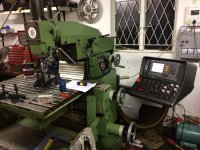noltelouis
Plastic
- Joined
- Feb 3, 2016
Good day all.
I bought a Deckel FP3A about a year ago. I have never used the horizontal spindle of the machine, until last week. There was a lot of tool chatter on this spindle, and when I investigated a bit further, I saw that it had about 0.15mm (yes that's right, 0.15mm) radial play.
I build up the courage, and stripped the quill out of the machine and opened the spindle. It was worse than I thought. It had been contaminated by what I can only think is coolant. There was so much corrosion that the needle roller bearing close to the spindle end had stopped rotating completely.
I have now done a lot of research on the rebuilding of these spindles, and I know that it is a very precise and specialist task. I'm also not sure if they can be rebuild from this condition, as I don't know to what extent there will be "oversized" needle rollers available for such a rebuild, as I can imaging a lot of material will have to be removed to clean up the spindle and housing?
Then, also the question of an "economically viable" repair come to mind.
I know there is a lot of people stating how full of problems these specific FP3A were, so maybe someone has one standing around as a "statue" (as so many has called it once the electronics stops working), that they would be willing to part out?
Any help or advice will be greatly appreciated!
Regards to all the Deckel fans out there!




I bought a Deckel FP3A about a year ago. I have never used the horizontal spindle of the machine, until last week. There was a lot of tool chatter on this spindle, and when I investigated a bit further, I saw that it had about 0.15mm (yes that's right, 0.15mm) radial play.
I build up the courage, and stripped the quill out of the machine and opened the spindle. It was worse than I thought. It had been contaminated by what I can only think is coolant. There was so much corrosion that the needle roller bearing close to the spindle end had stopped rotating completely.
I have now done a lot of research on the rebuilding of these spindles, and I know that it is a very precise and specialist task. I'm also not sure if they can be rebuild from this condition, as I don't know to what extent there will be "oversized" needle rollers available for such a rebuild, as I can imaging a lot of material will have to be removed to clean up the spindle and housing?
Then, also the question of an "economically viable" repair come to mind.
I know there is a lot of people stating how full of problems these specific FP3A were, so maybe someone has one standing around as a "statue" (as so many has called it once the electronics stops working), that they would be willing to part out?
Any help or advice will be greatly appreciated!
Regards to all the Deckel fans out there!








